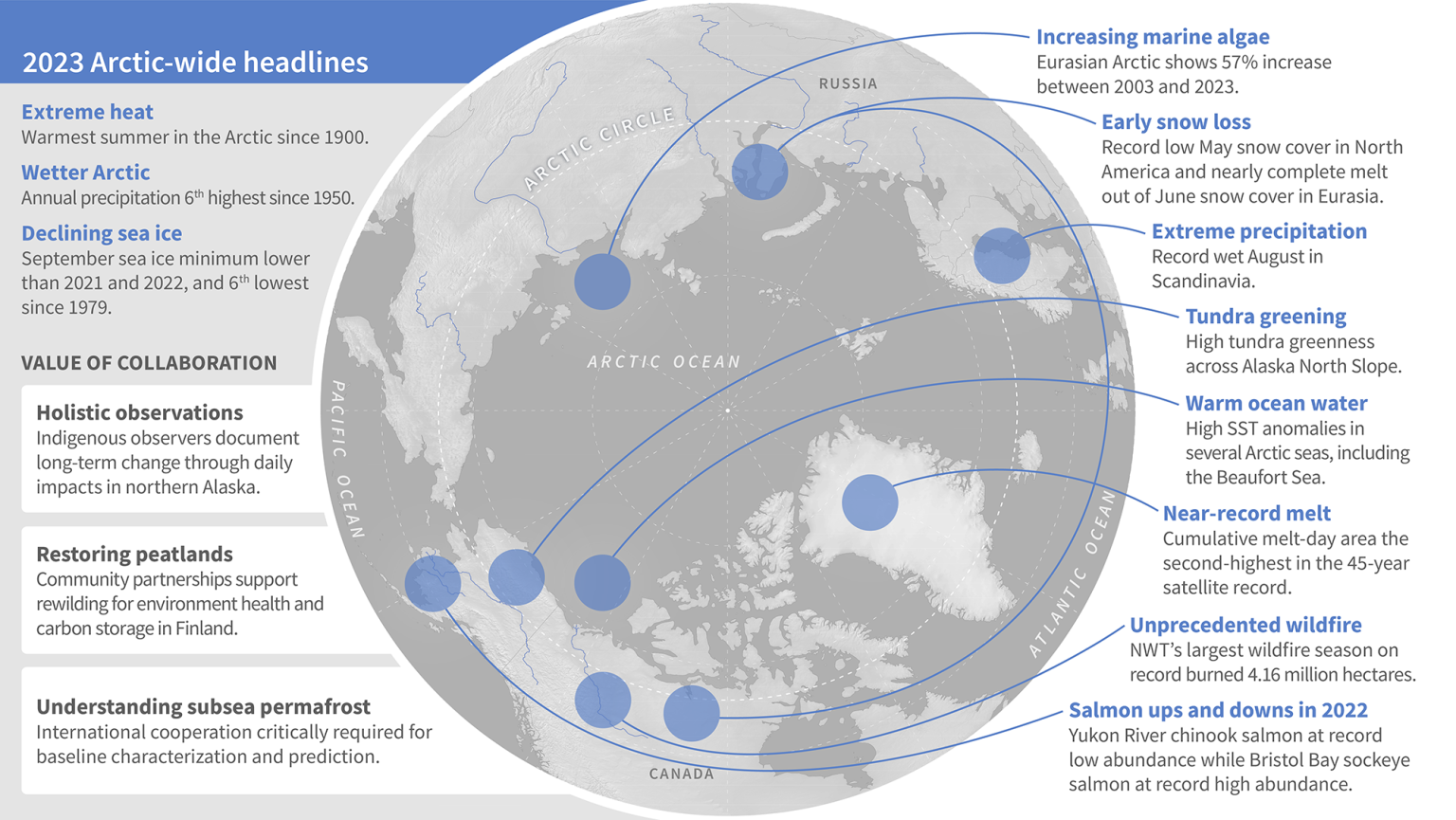Biodiversity & Environment
Annual Arctic Report Card: NOAA
- 18 Dec 2023
- 7 min read
For Prelims: Annual Arctic Report Card, National Oceanic and Atmospheric Administration (NOAA), Arctic, Permafrost, Global Warming, Greenland’s ice sheet, Wildfires.
For Mains: Annual Arctic Report Card: NOAA, Environmental pollution and degradation.
Why in News?
Recently, the National Oceanic and Atmospheric Administration (NOAA) has released its 18th Annual Arctic Report Card, highlighting the profound impact of extreme weather and Climate Events on the Arctic.
- NOAA is a United States government agency that is responsible for providing accurate and timely information about weather forecasts, climate, oceans, coasts, and even the exploration of outer space.
What is the Arctic Report Card?
- It has been Issued annually since 2006, the Arctic Report Card is a timely and peer-reviewed source for clear, reliable and concise environmental information on the current state of different components of the Arctic environmental system relative to historical records.
What are the Key Highlights of the Arctic Report Card?
- Record High Temperatures:
- The 2023 summer was the warmest on record in the Arctic, which, due to climate change, has warmed nearly four times faster than the globe since 1979.
- This year was noted as the sixth warmest in the Arctic since reliable records began in 1900.
- Impact of Rising Temperatures:
- The soaring temperatures led to unprecedented wildfires, forcing community evacuations, a decline in sea ice extent, severe floods, food insecurity, and rising sea levels.
- These impacts directly affect ecosystems, human health, and cultural practices.
- The soaring temperatures led to unprecedented wildfires, forcing community evacuations, a decline in sea ice extent, severe floods, food insecurity, and rising sea levels.
- Thawing of Subsea Permafrost:
- Warmer ocean temperatures are accelerating the thawing of subsea Permafrost, releasing methane and carbon dioxide.
- This process contributes to Global Warming and exacerbates ocean acidification. There's concern about the unknown extent and impact of these released greenhouse gasses.
- Food Insecurity Due to Salmon Decline:
- Western Alaska experienced significantly reduced populations of Chinook and chum salmon (81% and 92% below the 30-year mean, respectively), impacting Indigenous communities reliant on these fish for sustenance.
- This decline has cultural, food security, and economic implications.
- Wildfires in Arctic Regions:
- Canada witnessed its worst wildfire season on record, affecting 40% of its land mass considered Arctic and Northern.
- High temperatures and dry conditions facilitated the burning of over 10 million acres in the Northwest Territories, leading to evacuations and diminished air quality.
- Glacier Thinning and Flooding:
- Rising temperatures have led to dramatic thinning of the Mendenhall Glacier, located in Alaska, over the past 20 years
- As a result, over the years, the meltaway water has annually caused floods in the region.
- One such disaster took place in August 2023, when “a glacial lake on a tributary of the Mendenhall Glacier burst through its ice dam and caused unprecedented flooding and severe property damage” in Alaska’s Juneau.
- Greenland Ice Sheet Melting:
- Greenland’s ice sheet experienced melting for only the fifth time in the 34-year record. Not only this, the ice sheet continued to lose mass despite above-average winter snow accumulation — between August 2022 and September 2023, it lost roughly 350 trillion pounds of mass. Notably, Greenland’s ice sheet melting is the second-largest contributor to sea-level rise.
What is the Arctic?
- The Arctic is a polar region located at the northernmost part of Earth.
- Land within the Arctic region has seasonally varying snow and ice cover.
- It consists of the Arctic Ocean, adjacent seas, and parts of Alaska (United States), Canada, Finland, Greenland (Denmark), Iceland, Norway, Russia, and Sweden.
UPSC Civil Services Examination Previous Year Question (PYQ)
Prelims
Q. Which of the following statements is/are correct about the deposits of ‘methane hydrate’? (2019)
- Global warming might trigger the release of methane gas from these deposits.
- Large deposits of ‘methane hydrate’ are found in Arctic Tundra and under the sea floor.
- Methane in atmosphere oxidizes to carbon dioxide after a decade or two.
Select the correct answer using the code given below.
(a) 1 and 2 only
(b) 2 and 3 only
(c) 1 and 3 only
(d) 1, 2 and 3
Ans: (d)
Exp:
- Methane hydrate is a crystalline solid that consists of a methane molecule surrounded by a cage of interlocking water molecules. It is an “ice” that only occurs naturally in subsurface deposits where temperature and pressure conditions are favourable for its formation.
- Regions with suitable temperature and pressure conditions for the formation and stability of methane hydrate– sediment and sedimentary rock units below the Arctic permafrost; sedimentary deposits along continental margins; deep-water sediments of inland lakes and seas; and, under Antarctic ice. Hence, statement 2 is correct.
- Methane hydrates, the sensitive sediments, can rapidly dissociate with an increase in temperature or a decrease in pressure. The dissociation produces free methane and water, which can be triggered by global warming. Hence, statement 1 is correct.
- Methane is removed from the atmosphere in about 9 to 12-year period by oxidation reaction where it is converted into Carbon Dioxide. Hence, statement 3 is correct.
- Therefore, option (d) is the correct answer.
Mains
Q. How do the melting of the Arctic ice and glaciers of the Antarctic differently affect the weather patterns and human activities on the Earth? Explain. (2021)
Q. What are the economic significances of discovery of oil in Arctic Sea and its possible environmental consequences? (2015)





